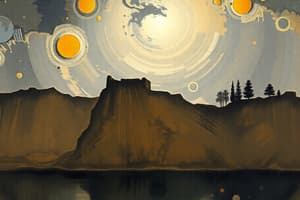Podcast
Questions and Answers
If a geologist discovers a new layer of rock containing fossils of early multicellular organisms but no complex cells, in which eon did this rock layer likely form?
If a geologist discovers a new layer of rock containing fossils of early multicellular organisms but no complex cells, in which eon did this rock layer likely form?
- Archean Eon
- Phanerozoic Eon
- Hadean Eon
- Proterozoic Eon (correct)
Which of the following represents the correct order of geological time divisions, from largest to smallest?
Which of the following represents the correct order of geological time divisions, from largest to smallest?
- Era, Eon, Period, Epoch
- Eon, Era, Period, Epoch (correct)
- Eon, Era, Epoch, Period
- Epoch, Period, Era, Eon
The boundary between which two eras is marked by a major extinction event likely caused by an asteroid impact?
The boundary between which two eras is marked by a major extinction event likely caused by an asteroid impact?
- Paleozoic and Mesozoic
- Proterozoic and Phanerozoic
- Mesozoic and Cenozoic (correct)
- Archean and Proterozoic
During which eon did the Earth's atmosphere begin to accumulate significant amounts of oxygen due to the activity of newly emerging life forms?
During which eon did the Earth's atmosphere begin to accumulate significant amounts of oxygen due to the activity of newly emerging life forms?
If scientists were to formally recognize the Anthropocene as a geological epoch, what primary characteristic would define its start?
If scientists were to formally recognize the Anthropocene as a geological epoch, what primary characteristic would define its start?
Flashcards
Geologic Time Scale
Geologic Time Scale
Chart organizing Earth's 4.6 billion year history, divided into eons, eras, periods, and epochs.
Hadean Eon
Hadean Eon
The earliest eon in Earth's history, when Earth was a hot, rocky ball and the moon formed.
Archean Eon
Archean Eon
Eon when continents formed and life emerged in the oceans, releasing oxygen into the atmosphere.
Proterozoic Eon
Proterozoic Eon
Signup and view all the flashcards
Mesozoic Era
Mesozoic Era
Signup and view all the flashcards
Study Notes
- The geologic time scale is a chart created by geologists to organize and remember Earth's 4.6 billion years of history.
Time Scale Breakdown
- Eons are the largest divisions of time.
- Eras divide eons.
- Periods divide eras.
- Epochs are the smallest divisions of time, dividing periods.
Hadean Eon
- The first eon, lasting about 500 million years.
- Earth was a hot, rocky ball during this time.
- The moon formed during the Hadean.
Archean Eon
- Follows the Hadean, lasting almost 1.5 billion years.
- Continents began to form.
- Life started to emerge in the oceans.
- New life forms released oxygen into the atmosphere towards the end.
Proterozoic Eon
- Meaning "early life," but characterized by very small life forms.
- The first complex cells appeared.
- The first multicellular organisms developed.
- This eon lasted approximately 2 billion years.
- Plants and animals first appeared at the end of the Proterozoic.
Phanerozoic Eon
- Meaning "visible life."
- Began about 500 million years ago and continues to the present.
- Marked by an explosion of diverse life forms.
- Divided into three eras: Paleozoic, Mesozoic, and Cenozoic.
Paleozoic Era
- Meaning "old life," characterized by "squiggly" or "wormy" life.
Mesozoic Era
- Meaning "middle life," known as the "dino life" era.
- Ended with a large asteroid impact that caused mass extinction.
Cenozoic Era
- Meaning "new life," known for "furry life" and "flappy flying life."
- The era of flowering plants and diverse mammals and birds.
Anthropocene
- Proposed new geological epoch.
- Suggests human activity has significantly altered the Earth.
Studying That Suits You
Use AI to generate personalized quizzes and flashcards to suit your learning preferences.
Description
Explore the structure of the geologic time scale, including eons, eras, periods, and epochs. Learn about the Hadean, Archean, and Proterozoic eons, marking Earth's early history. Discover when life began to emerge.




